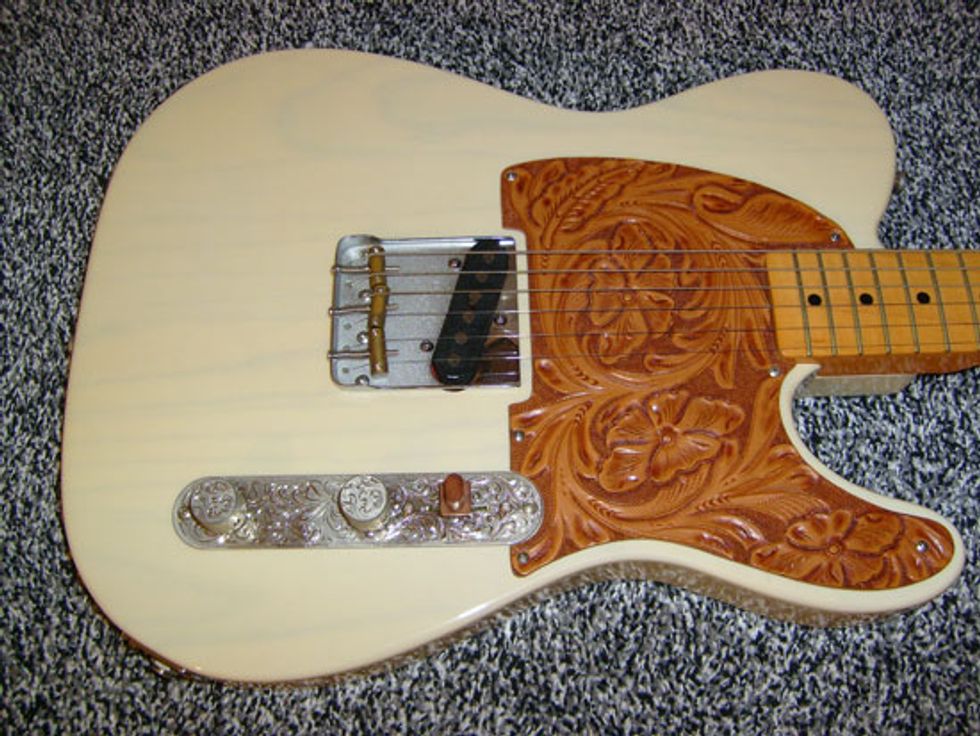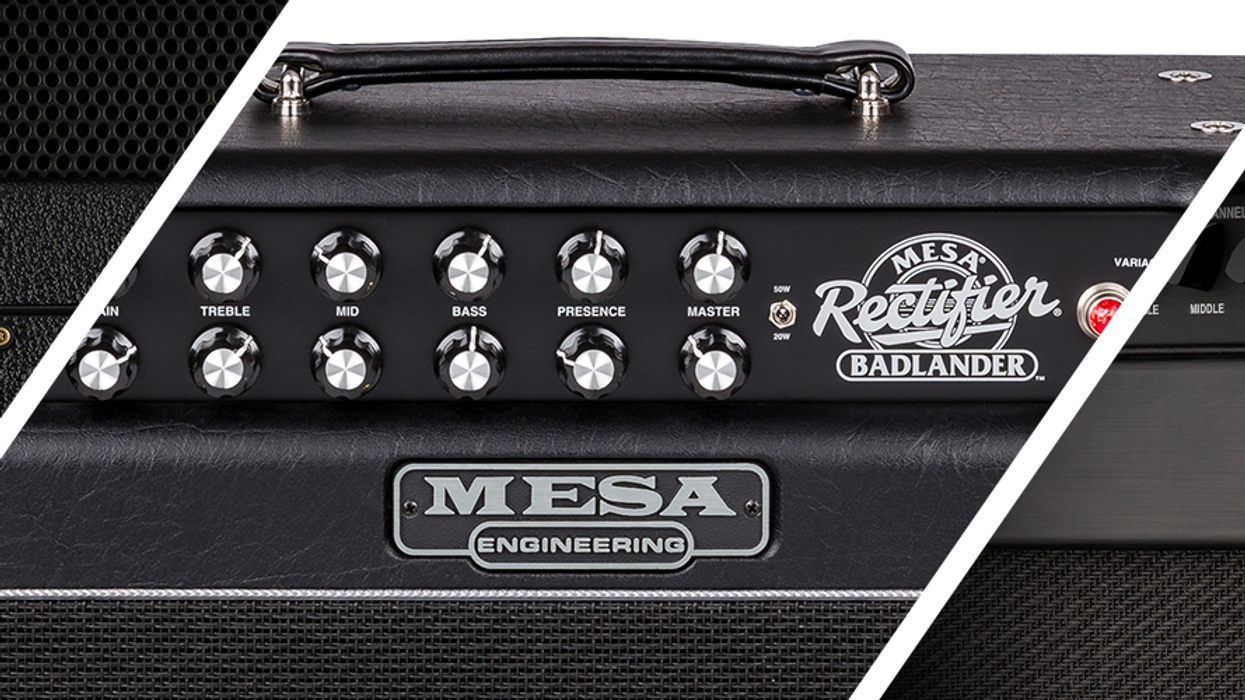Since I'm a regular Esquire player who plays in a local Johnny Cash tribute band (please note, it's a tribute band, not a cover band!), I receive this question all the time: How can I achieve that authentic "boom-chicka-boom" Johnny Cash tone with such a guitar? You don't need much for this specific tone, just the following will do:
• An Esquire or a Telecaster.
• A clean-sounding tube amp, preferably with built-in reverb.
• A delay stompbox.
• A reverb stompbox if your amp lacks built-in reverb.
• Specific strings and picks.
The tone is 50 percent equipment and 50 percent technique know-how. Luther Perkins was Johnny Cash's original electric guitarist from 1955 until his untimely death in 1968 at age 40. Luther, aka "The original man behind the Man in Black," was not a professional guitarist, but a mechanic who played guitar as a hobby. Nailing his playing style is a great lesson in minimalism, because Luther never played any wild solo parts or fancy chords like his successor Bob Wootton did on later Cash recordings. Luther liked early Fender guitars, and especially the Esquire, his model of choice. Besides short romances with a Jazzmaster and a Jaguar, Luther played Esquire guitars until he died.
So, what does "boom-chicka-boom" style mean? It's an onomatopoetic word, similar to the fast, stomping tone from a freight train in motion. Several urban legends exist about how Luther Perkins developed this tone by accident. One story goes that his first Esquire had a defective volume pot, so if he wanted to play softer, he had to palm-mute the strings at the bridge—finger muting was a technique Luther never mastered. Another version is that his first Esquire was not set up properly at all, so the strings permanently hit the frets while playing and to solve this problem, Luther palm-muted the strings with his right hand. Whatever it really was, it's a fact that Luther developed this famous playing style and it remains his unique invention.
Luther Perkins' '55 Fender Esquire.
Now let's walk through the equipment, per item.
Guitars: Fender Esquire or Telecaster
Any standard Esquire will do. You can also use a standard Tele, just make sure that the bridge pickup is a vintage-flavoured standard model, not a stacked humbucker or any other modern type. An Esquire will sound a tad more authentic, because of the reduced magnetic pull from the missing neck pickup, but for your first attempts your good ol' Telecaster will do. I play a custom Esquire in white blonde, nicknamed the "Luthercaster," and it is optically spruced up with engraved nickel hardware and a tan leather pickguard with matching selector switch tip.
Amp: Fender Tweed or other Warm, Clean Amp
Luther played many Fender tube amps throughout his career, mostly Tweed amps, but also Blackface amps in the mid-'60s. There are pictures of him with a '55 Princeton, '59 Bassman, Deluxe, and many others. You can use any warm-sounding tube amp, as long as it sounds clean. Luther never played with overdrive, so stay away from the hot channel of your amp. Personally, I use different amps, depending on the gig. For small club gigs I love to play a Fender Blackface Princeton Reverb, for bigger venues I choose a MusicMan RD112-50, and for the really big ones a Fender Silverface Twin Reverb—the 135-watt, ultra-linear version with four power tubes. Set the reverb between 2 and 4, depending on your taste. I set my reverb to 3, sometimes 4, depending on the stage.
Effects: Delay and Reverb
Any delay stompbox will do, though I think the analog delays sound smoother and better for this kind of music, compared to digital ones. Tape echoes and tape echo simulations work well, too. To nail the famous early delay sound from the Sun Record sessions, set the feedback (aka "Intensity") to zero for one repeat, the Delay Time (aka "Repeat Rate") to 137ms and the Level (aka "Echo") between 1/2 and 3/4 of the original signal and play along.
If you use an amp without built-in reverb, you can use the external Reverb tank from Fender, or any other reverb stompbox. Don't overdo it together with delay—the reverb is just to add some ambience to the tone, not the main effect.
Strings: Flatwounds
The most important parameter is the strings. To really come close to the original tone, you will have to use heavy flatwound strings, as modern roundwound strings are not suitable for an authentic tone. I use .012 pure nickel flatwounds, and they really sound great. It's a funny thing, but the longer the strings are on the guitar, the better they sound. With a little care, you can use such sets for a very long time without tone degeneration. It might take time to get used to playing these strings, but once you master this, you will be amazed about how good they sound. If you want to use heavy strings, make sure the neck of your guitar can handle this pressure—ask an experienced local guitar tech or luthier. You will also need a new nut to use flatwound strings or have your original nut reshaped. The standard nut for roundwound strings will not work properly. Unbleached bone will work best here. (To add a little flair, polish it like I do.)
To move these heavy strings, you can't use your modern, ultrathin shredding plec. Use a heavy or extra heavy plec out of celluloid, as Luther did. You can use your favorite shape—such plecs are available from a lot of different companies in almost unlimited shapes. I stick with an original Fender standard 351-shaped heavy pick in tortoise for a snappy and percussive attack.
The "Luthercaster"
photo courtesy of singlecoil.com
Technique
Musically you don't need much: Luther preferred the simple chords like A, B7, C, D, E, F and G. In pictures of him playing his favorite Esquire, it's clear to see that he liked A and E best, playing in the first few frets. To start with a little Luther Perkins rhythm playing, listen to some early Johnny Cash to get used to this groove. When you're ready to start, take your right hand and place it gently on the bridge for some palm muting. Play an open E chord, hit the 6th open string, which is E. Then hit the 4th string, which you are fretting at the second fret, which is another E, just an octave higher. Then hit the 5th string which will be fretted at the 2nd fret, which makes a B note, and back up to your 4th string again to your octaved E note.
Got the idea? It's a very simple progression and you will need only a short time to get used to this playing style. Essentially, Perkins doubled the bass lines, playing in a 3:1 ratio. Start slowly and speed up over time as you become comfortable with this style. The hardest lesson may be to coerce yourself to stay with these basic notes through a whole song. If you mastered the E chord, you can go on to the A chord, which will follow the same pattern and it should be simple for you to figure out what to do.
Believe me, with this tone you will only need two songs until your audience is dancing on the tables, raising their glasses, and shouting for more.
Dirk Wacker lives in Germany and has been a guitar addict since age 5. He is fascinated by anything related to old Fender guitars and amps. He plays country, rockabilly, and surf music in two bands, works regularly as a studio musician, and writes for several guitar mags. He is also a hardcore DIY-er for guitars, amps, and stompboxes, and he runs an extensive
website—singlecoil.com—on the subject.










![Rig Rundown: Russian Circles’ Mike Sullivan [2025]](https://www.premierguitar.com/media-library/youtube.jpg?id=62303631&width=1245&height=700&quality=70&coordinates=0%2C0%2C0%2C0)

















